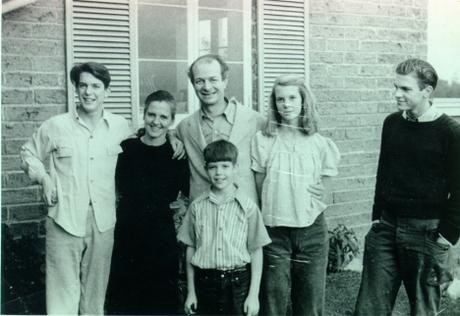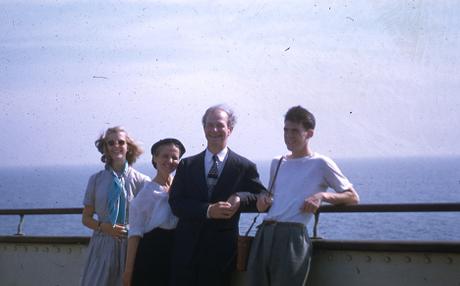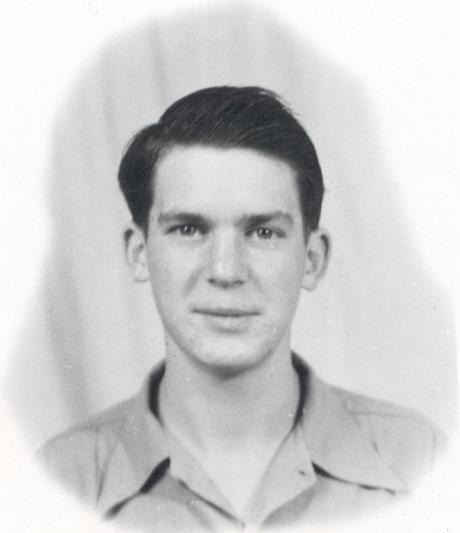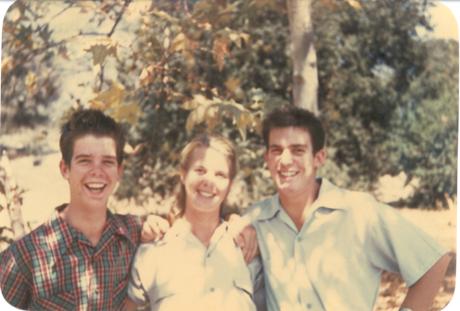
The Pauling family in 1946. From left: Peter, Ava Helen, Linus, Crellin, Linda and Linus Jr.
[The life story of Peter Pauling, part 2 of 9]
In April 1945, while German forces were surrendering to the Allies in Europe, Peter Pauling was completing his education at Flintridge Prep and moving on to McKinley Junior High, where he would enter the 10th grade. He continued to do well in most subjects, with the exception of a few poor marks in Latin. Now fourteen years of age, Peter went outside of the Pauling family home in Pasadena one day to discover a message painted on their garage door; it read: “AMERICANS DIE BUT WE LOVE JAPS. JAPS WORK HERE, PAULING.” Peter quickly called for his parents, who surmised that the hate message had been written by misguided individuals angered by Ava Helen’s work with the American Civil Liberties Union to prevent the internment of many Japanese-American citizens during the war.
Within the year, Linus Jr., now twenty-one years old, had returned home from his time in the Army Air Corps. He promptly came into possession of a 1932 Ford V8 roadster that had belonged to the Mt. Wilson astronomer Ted Dunham, Jr. The car would become something of an heirloom of burgeoning adulthood for the Pauling boys, passing to Peter when Linus Jr. went off to medical school, and then again to Crellin when Peter finished college in California and went off to Cambridge.

Peter Pauling sitting in the frame of a converted 1932 Model-B Ford, 1947.
In 1947, Linus and Ava Helen returned from a scientific congress in Scandinavia to find their three youngest children growing somewhat depressed by, and resentful of, their frequent long absences. Knowing that they were about to spend six months in England, where Linus would lecture as a visiting professor at Oxford, the Paulings decided it best to take the entire family abroad with them. They traveled by train to New York City in December, where they then boarded The Queen Mary and crossed the Atlantic.
The voyage would prove to be an extraordinary missed opportunity for Linus. Onboard was Erwin Chagraff, who was excited to talk with Pauling about his discovery that DNA nucleotide base pairs obeyed a set rule – a 1:1 ratio of adenine to thymine and cytosine to guanine. As Crellin Pauling later recounted
Chargaff had a reputation as a, well how do you put it politely, as a difficult personality. And what Daddy said to me was that he found Chargaff so unpleasant to be trapped on the Queen Mary with, that he dismissed his work.
In doing so, Pauling overlooked the importance of a critical piece of knowledge that would help lead Watson and Crick to the discovery of the structure of DNA – a discovery with which both Linus Pauling and his son Peter would be intimately involved.

The Paulings at sea, 1948. Peter stands at right.
After the family returned from England, Peter made the fateful decision to follow in his father’s footsteps, enrolling at Caltech as an undergraduate and assuring his father that his “chief purpose in life” was to be a physicist. Unlike the elder Pauling, however, Peter gravitated almost immediately to those new freedoms that a young man no longer under his parents’ roof might be expected to find suddenly and inescapably important: cars, girls, and parties.
With respect to the former, Peter wrote to his father from Caltech, asking whether or not Linus might be interested in helping to pay for a new engine for the roadster. Peter had already been putting some work into the car since it had passed from Linus Jr.’s hands into his own. Now off at college and free to pursue his own interests, he was eager to get under the hood.
Peter likewise wrote to his mother asking her for advice on different perfumes, listing the names of four different girls, all of whom were apparently familiar to Ava Helen, and asking which scents she thought that each would prefer (he then added a fifth young lady to the list as an afterthought).
While Peter was at Caltech, the Pauling home in Pasadena became something of a social hotspot for young, aspiring scientists, many of them graduate students and postdocs who coveted the opportunity to hobnob with the great Linus Pauling. By right of birth and strength of personality, Peter emerged as both gatekeeper and VIP at such events, and he thrived in this atmosphere. In his biography of Pauling’s life, Force of Nature, author Thomas Hager paints a scene of pilgrims making their way up into the hills on warm afternoons for, “a beer, a dip in the pool, some jokes with Peter, and a chance to flirt with tall, slim, blond, teenaged Linda Pauling.”

Peter Pauling, ca. late 1940s.
Peter, now nineteen and cruising the streets of Pasadena at night in the modified “hand me down” roadster, was the life of many of these parties. His undergraduate years were accordingly marked by the ecstasies, despairs, and calamities – including a long and somewhat severe case of infectious mononucleosis – familiar to many college students. His father, observing from the middle distance, sent him a stern letter during this period, noting that he had opened some mail at the house intended for his son and that it was from the Bank of America, alerting Peter that his account was overdrawn by 50 cents. Pauling then advised his son, in great detail, as to how he should best manage his finances to avoid such a problem in the future.
Though they lived in the same city and worked at the same institution, Peter corresponded often with his father, expressing relatively little concern about his finances and far more with the prospect of being called up for the draft. In June 1950, North Korea, aided by the Soviet Union, invaded South Korea, where United States troops had been stationed since the ousting of Japanese occupation at the close of the Second World War. As hostilities in the Korean peninsula ramped up, Peter grew increasingly fearful of being called upon to serve.
The elder Pauling advised that his son request a deferment as a student of physics, which Peter sought and successfully attained. Part of Peter’s later motivation to spend some of his time as an undergraduate in London likewise emerged from his desire to avoid the draft for as long as possible. Peter felt that his enrollment as a student overseas would at least prolong his recruitment, whereas, if he remained at Caltech, he might he pulled in any day and waste his final undergraduate months in military training.

Peter Pauling with his parents, 1949.
Meanwhile, in the summer of 1951, Peter was involved in a serious car accident. The Pasadena Star News reported that, “While driving his father’s expensive 1949 sedan, Peter J. Pauling, 20, son of Linus Pauling, world-famed Caltech physicist, was injured in a spectacular traffic crash at Fair Oaks Avenue and Washington street.” The police report indicated that the Pauling car had been sideswiped by a Harry L. Nottingham, a 30-year old welder, at 2:11 AM.
The police jailed Nottingham overnight on a drunk driving charge, and Peter was treated at the emergency hospital for mild injuries to his head that had been sustained when his car flipped onto its roof after the impact. The accident happened less than a month before Peter was to leave California to spend his summer at a laboratory in Woods Hole, Massachusetts. His eventual departure back east left his parents quite literally picking up the pieces in his absence, as Peter had requested that they keep what remained of the vehicle to see what he could salvage.
His father later wrote to Peter while he was at Woods Hole, explaining that, even with compensation paid out by insurance and the drunk driver involved, the family would still, after legal fees, “come out a little bit in the hole from your use of the Lincoln that night.” Peter responded through his mother, writing “Please tell Daddy that I am sorry I ruined his car,” and asking that she remind him that, of the cars he could have wrecked that night, at least he chose the one that offered a barrier between his head and the road. The old Ford roadster was, after all, a convertible.

Crellin, Linda, and Peter Pauling, 1952.
Peter’s stint at Woods Hole was both formative and crucial to his next steps. While there, he studied ion movement in nerves using sodium and potassium tracers in squid axons. At the same time, Peter began seriously considering what institution to go to for graduate school, looking at Cambridge, among others. Fortuitously, John Kendrew, of Cambridge’s Cavendish Lab, was serving as a lecturer at Woods Hole and, unbeknownst to Peter, was recruiting for his protein structure research group.
Years later, Peter would recount that when Kendrew told Peter’s Woods Hole boss, David Nachmanson, that he had recruited him, Nachmanson replied, “What? That sex maniac?” Kendrew reportedly replied, “What does that matter?” In typical good humor, Peter offered that Kendrew had replied in this manner because he knew that being a “sex maniac” was an advantage at Cambridge. He later confessed, however, that his reputation was not well earned, admitting that he was likely “the most unsuccessful Don Juan in Woods Hole.”
While in Massachusetts, Peter was, in fact, pretty clearly agonizing over how to resolve his relationship with his college girlfriend, who remained in Pasadena. In his correspondence, Peter sometimes indicates a deep affection for his sweetheart, and at other times reveals significant doubt about any chance of a shared future.
It is entirely possible that the hot and cold nature of Peter’s feelings towards this woman were merely a reflection of a young man’s whimsies. It might also be argued that this was an early sign of a lifelong struggle with manic-depression that would come to plague Peter by the later stages of his graduate career at Cambridge. In any case, Peter’s beau was equally unsure. At times she seemed to favor the appraisal of her father, a high-ranking scientific adviser to the American military who was stationed in Europe. The father believed that marriage would prematurely end his daughter’s own academic ambitions and that, more broadly, Peter was bad news.
However, by the following summer of 1952 – just before Peter left for Cambridge – she had warmed to her boyfriend again. It was a summer of exploration; the two crossed the nation prior to the beginning of graduate school for Peter, traveling together to New York, Washington D.C., Princeton, and Long Island. Their romance seemed to burn brightly, if briefly, as Peter’s life in America drew to a close.
In the last few months before leaving the states, Peter and Crellin visited Hawaii, staying with their older brother Linus Jr, who lived there. Meanwhile, Linus and Ava Helen were engaged in world travels of their own, making lengthy stops in France and England. Peter wondered aloud if he would get the chance to see his parents upon his brief return to Pasadena, or if, instead, he would be gathering his belongings from an empty house, departing with the well wishes of Linda and Crellin, and setting out alone for Montreal, where he would board a ship to cross the Atlantic.
The exact circumstances of Peter’s bon voyage from southern California are unknown, but by September 1952, Peter was on his way to a new life in England.
